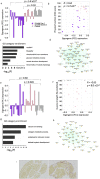Transcriptomic analysis reveals abnormal muscle repair and remodeling in survivors of critical illness with sustained weakness
- PMID: 27411715
- PMCID: PMC4944143
- DOI: 10.1038/srep29334
Transcriptomic analysis reveals abnormal muscle repair and remodeling in survivors of critical illness with sustained weakness
Abstract
ICU acquired weakness (ICUAW) is a common complication of critical illness characterized by structural and functional impairment of skeletal muscle. The resulting physical impairment may persist for years after ICU discharge, with few patients regaining functional independence. Elucidating molecular mechanisms underscoring sustained ICUAW is crucial to understanding outcomes linked to different morbidity trajectories as well as for the development of novel therapies. Quadriceps muscle biopsies and functional measures of muscle strength and mass were obtained at 7 days and 6 months post-ICU discharge from a cohort of ICUAW patients. Unsupervised co-expression network analysis of transcriptomic profiles identified discrete modules of co-expressed genes associated with the degree of muscle weakness and atrophy in early and sustained ICUAW. Modules were enriched for genes involved in skeletal muscle regeneration and extracellular matrix deposition. Collagen deposition in persistent ICUAW was confirmed by histochemical stain. Modules were further validated in an independent cohort of critically ill patients with sepsis-induced multi-organ failure and a porcine model of ICUAW, demonstrating disease-associated conservation across species and peripheral muscle type. Our findings provide a pathomolecular basis for sustained ICUAW, implicating aberrant expression of distinct skeletal muscle structural and regenerative genes in early and persistent ICUAW.
Figures




References
-
- Batt J. et al. MEND ICU-Muscle Injury and Repair in Critical Illness Survivors Mechanically Ventilated for Over 7 Days. Am J Respir Crit Med 191, A2288 (2015).
Publication types
MeSH terms
Grants and funding
LinkOut - more resources
Full Text Sources
Other Literature Sources
Medical
Molecular Biology Databases

